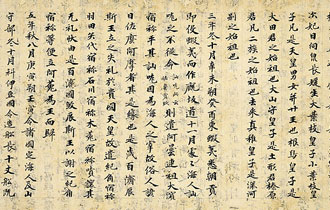Pages |
Third, in 1939, war broke out in Europe, and by the summer of 1940, Germany had conquered Norway, Denmark, Belgium, Holland, and much of France. The rest was organized into the Vichy regime, under the leadership of Marshal Petain, which collaborated with the Nazis. This meant that French Indochina, that is, present-day Vietnam, Laos, and Cambodia, was the territory of a regime friendly to Japan. Fourth, the German blitzkrieg victories of 1940 strengthened the hands of the fascist faction in Japan. In July, Prime Minister Konoe Fumimaro ordered his foreign minister, Matsuoka Yosuke, to begin negotiations with Germany and Italy for a three-nation pact, and in September the Tripartite Pact was signed in Berlin. The treaty recognized the "new order" in Europe and Asia, that is, the leadership of the three signatory nations in their respective parts of the world, and also obligated the other two powers to enter a war against any major nation if that nation were to enter the war. Because in autumn of 1940, the United States was the only power not yet involved in the war, it was clear to all three Axis nations whom the alliance targeted. The victories of Japan's new German ally emboldened the Japanese military to act decisively.
Pacific War
In the same month that Japan signed its treaty with Germany and Italy, Japanese army moved into northern Indochina, into the colony of its French "ally." This action motivated the United States to begin incrementally embargoing the export of goods to Japan. In the summer of 1941, as Japan moved into southern Indochina, the United States, together with its British and Dutch allies, froze Japanese assets in the United States and placed a strict embargo on the export of oil to Japan. Since the United States was the primary source of petroleum that fueled Japan's ships and airplanes, Japan was in a desperate situation. While the United States took these steps to force the Japanese to compromise, the leaders of the imperial army and navy, looking at the world from their own hard-line position, felt that they were forced into a corner, and that compromise was not an option. In spite of the relative strength of the U.S. economy and British economies (the U.S. was over five times, and the British twice as large as the Japanese economy in 1941), the only choice for Japan's leaders, from their perspective, was war. The war began on December 7, 1941 (December 8, Tokyo time), when the Japanese navy attacked Pearl Harbor. It is almost certain that the fuel that moved the attacking fleet and powered the attacking planes came from Texas and Oklahoma.
The war between the United States and its allies and Japan can be divided into four phases: first, Japan's initial overwhelming success from December 7, 1941 until the summer of 1942. During this time, Japan not only crippled the U.S. Pacific fleet at Pearl Harbor, but also conquered the American colony in the Philippines, the British colonies in Malaya, Burma, and Singapore, the Dutch colonies in Sumatra, Java, Borneo, Celebes, and the other islands that now comprise Indonesia, most of the immense island of New Guinea, and a variety of other south and central Pacific islands. In fact, Japan, in these approximately seven months of running wild, conquered far more territory than in their wildest projections prior to the start of the war.
The second phase can best be called "deadlock in the Pacific," from the time of the Battle of Coral Sea in May 1942, when the Japanese were forced to abandon their plan to seize Port Moresby in southeastern New Guinea to threaten American supply lines to Australia, and of the Battle of Midway in June 1942, when the Japanese carelessly lost four aircraft carriers and hundreds of planes and skilled pilots, until the American counterattack began in earnest with the landing on Tarawa in the Gilbert Islands (present-day Kiribati) in November 1943.
Pages |











